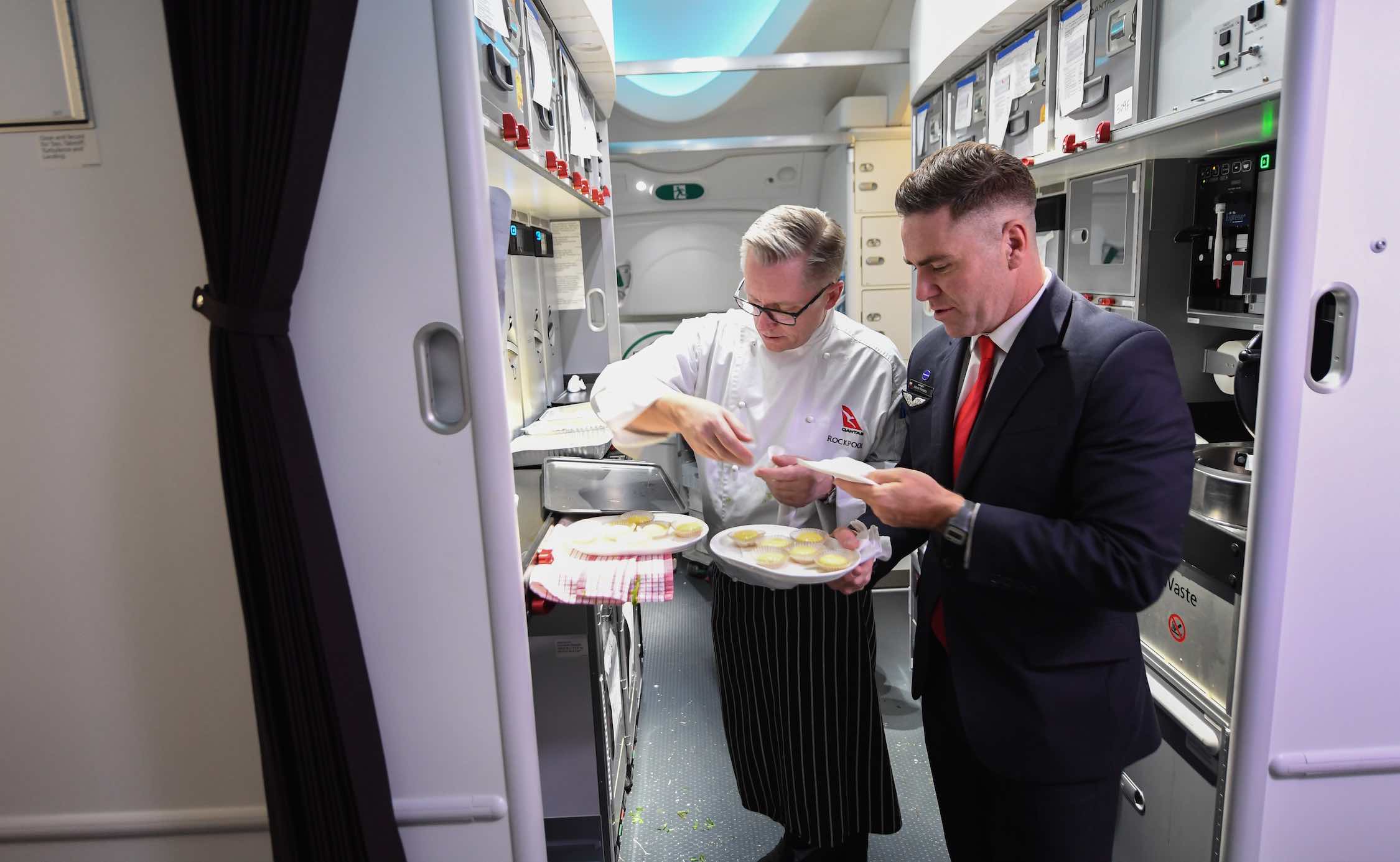
As it prepares to launch new ultra-long-haul flights to London and New York, Qantas commissioned a study to probe which foods aided in the fight against jet lag. The results give us a hint of what the in-flight cuisine may look like.
Qantas Identifies Foods That Will Reduce Jet Lag
Project Sunrise is the code name for Qantas’ plan to launch ultra-long-haul service from Sydney and Melbourne to key destinations around the globe currently not reachable nonstop. That includes:
- Cape Town
- Chicago
- Frankfurt
- London
- New York
- Paris
- Rio de Janeiro
Flights from Sydney to London could be as long as 22-hour one-way when traveling west and a key part of the value proposition will not just be the direct service, but how to help passengers minimize jet lag on board.
Qantas began working with the University of Sydney’s Charles Perkins Centre in 2015 when it first began preparations to launch Perth to London direct flights (those flights are now operational) and operated three Project Sunrise research flights from New York and London to Sydney in 2019.
Through specially-designed menus, lighting, and sleep sequencing, Qantas reports that passengers experienced:
- less severe jet lag (self-reported)
- better sleep quality inflight
- better cognitive performance in the two days after the flight
In terms of food, chili and chocolate were particularly found to aid the body in adjusting to the conditions of the long-haul flight and rapid change in time zone. Per Qantas, the mixing of protein and carbs plus soup and milk-based sweets also helped:
They also adjusted the timing of meal services to align the body clock and encouraged wake and sleep by using specific menu items including fish and chicken paired with fast-acting carbohydrates, as well as comfort foods like soups and milk-based desserts. The aim was to promote the brain’s production of the amino acid tryptophan (‘Tryp’) to help passengers drift off more easily.
Research continues and Qantas boasts that it has a team of 10 scientists on staff to work on this project.
Qantas Group CEO Alan Joyce explained that not only will the Airbus A350-1000 aircraft used for these long-haul flights be more spacious, but that even the economy class experience will be more customizable than it presently is in terms of sleep and meals:
“Our A350s will have about 100 fewer seats than most of our competitors, which gives us room for more space in all classes as well as a Wellbeing Zone for Premium Economy and Economy passengers to stretch. People can choose how they spend their time but we’ll make recommendations based on science around menu choices and best times to eat or rest. That extends to before and after the flight to improve how people feel when they arrive on the other side of the world.”
CONCLUSION
Qantas will launch Project Sunrise service to London and New York in late 2025 and is working to ensure that the in-flight experience minimizes jet lag. Research has revealed that chili, chocolate, the right mix of carbs plus protein, soup, and milk-based desserts are best geared toward reducing jet lag from a dietary perceptive.
Even with world-class food, 22 hours will certainly be a long flight… especially in economy class.
image: James D Morgan/Qantas




I disagree with Qantas. Jet lag is the worse in places that are 12 hours opposite of home. That means Singapore (for NY) and India (for California). Australia is only a net difference of 5 hours (+1 day) from Los Angeles in the US winter. Food is negligible. Sleep is much more effective.
The main focus of Project Sunrise is neither New York nor Los Angeles, but the Kangaroo route to London. Nonstop flights between LHR and the not-hugely-important city of Perth already command insane fares upfront. I am definitely not the target audience of the Project as I was distinctly underwhelmed when I visited Oceania and, even if I had to go back, I certainly wouldn’t wish to board a 20+ hour flight in any cabin, but it is an experiment that’s worth observing.
Not sure if I would serve Chili on a plane …. the lower air pressure already has an effect to cause bloating …. air quality could be severly reduced
In my experience, the timing and size of meals is more important than the specific food. I have had good results following the “Jet Lag Diet” which introduces feast and fasting days leading up to the day of travel and ending with a full set of meals timed for the destination time zone. On your first fasting day you can already feel your body’s circadian rhythm “disassociating” from your current location. It’s not perfect, and if I am enjoying lounges or a premium cabin I won’t follow it, but it’s the best solution out there.
I cannot imagine being in a middle seat in coach on a 22 hour flight. I rather have a few stops in between if I am flying coach. It sounds brutal.
And you’d most likely be paying a $ premium for the nonstop. I really don’t know who’s going to be spending more to fly this in economy
These planes will be configured with reduced number of economy seats and much bigger premium sections
Everyone is different in their responses to jet lag. Amazing this, spending all that research money on what is absolutely a different experience from one to the next. Of course, none of these reports will come back with the fact that they need to make the seating configurations more humane. I could tell them that for free. Instead they will spend $4M to hire 10 expert consultants to tell them to serve chili and chocolate.
In the end, eat well, drink well, get enough water, take melatonin when you arrive and want to sleep, and just hope for the best. No researcher is going to pin down the exact scenario of every single passenger and their lives, body, systems, stress levels, etc to determine what’s best for you. And if someone wants to take a 20 hour flight that’s on them to decide if it’s right for their body.
After 20 hours everything in the cabin will ripen like stinky cheese. And the risk for DVT and pulmonary embolism drastically increase. Will they get everybody up to march up and down the aisles? No amount of chili and chocolate (mole sauce?) will fix that.
“room for more space in all classes” doesn’t mean that there will be more room in all classes.
Also, the chili on a long haul flight sounds like a real stinker of an idea.
Didn’t you hear…the pitch between economy seats is a whole 33″ instead of the standard 31″. How nice of Qantas to give economy customers a whole 2 inches!
I would like to know if this food science is even going to apply to economy class…because you the know that would mean spending money on the peasants.
22 hours? No. 17 hours is bad enough from the west coast to Singapore. I much prefer a layover en route from Australia to the UK.